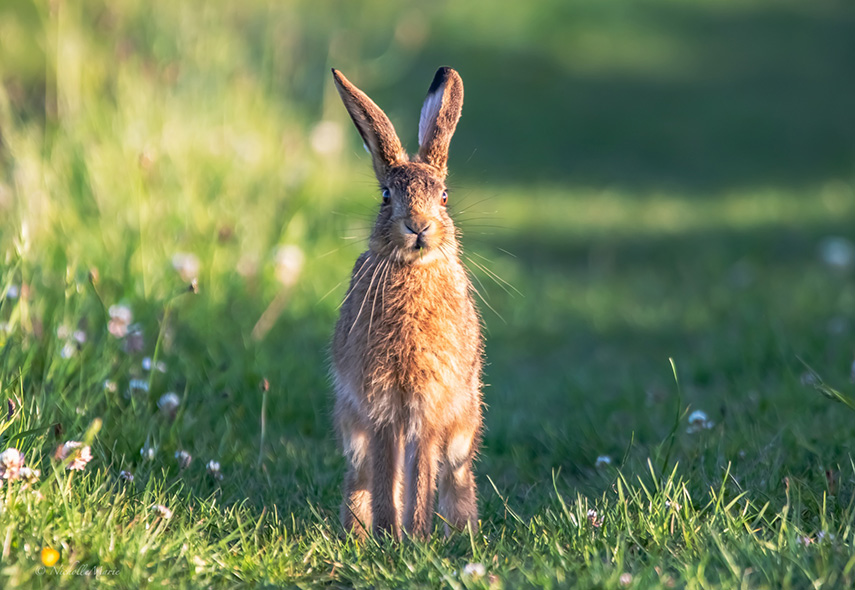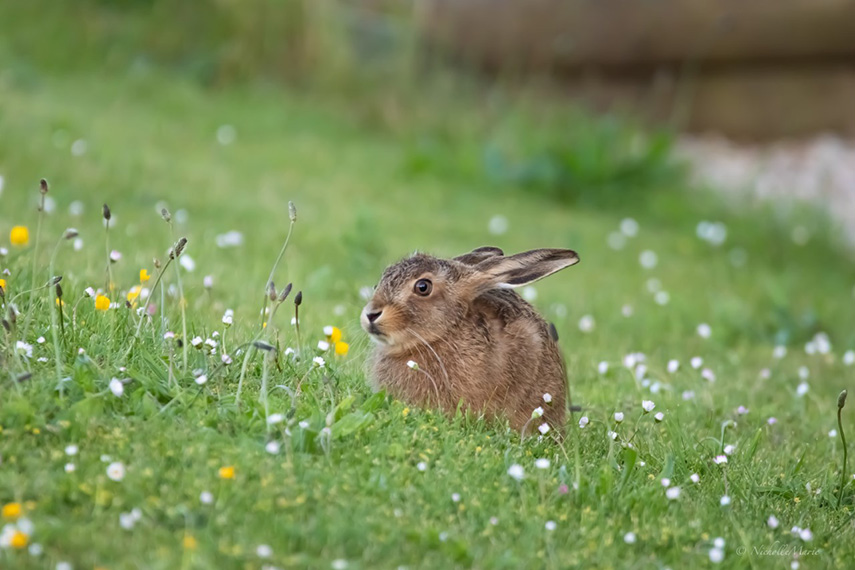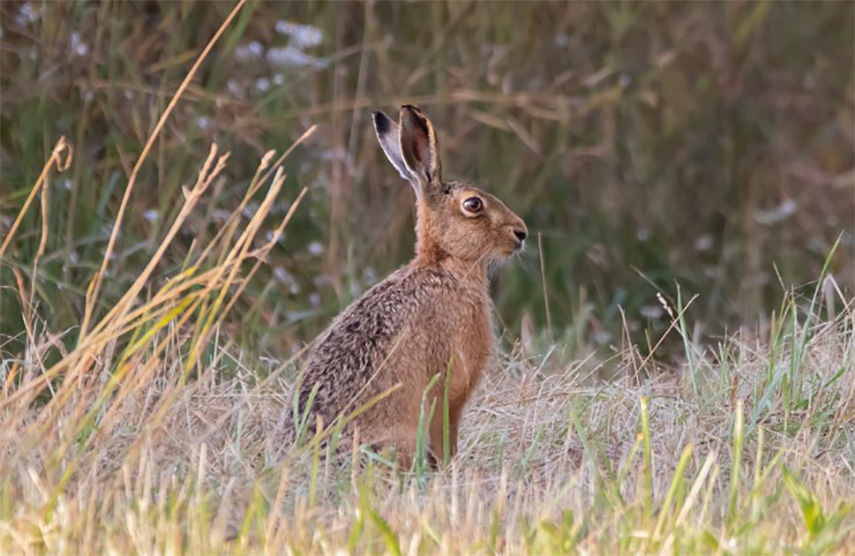Nature & Wildlife | Posted on July 8th, 2022 | return to news
Nature’s footprints through Dorset #10: Brown hare
Words by Janine Pulford • photography by Nicky Wicks and Sharon Towning

Although not native to the British Isles the brown hare, (Lepus europaeus), is now considered naturalised.
It originally evolved in central Asia, and is thought to have been introduced to this country some 2,000 years ago. Archaeological evidence points to the Roman times, or a bit before.
Identification
Hares are not rabbits. They are in the same family, Leporidae, but they are a different species.
Wild rabbits are smaller measuring about 40cm long and weighing up to 2kg whereas brown hares measure between 52-69cm and weigh in at around 2-5kg.
Close-up or seen through binoculars you will notice that brown hares have reddish gold fur, amber eyes and distinctively long ears with black tips. By comparison wild rabbits are light brown, have shorter ears without black tips, and brown eyes. Rabbits generally hop along and when scared will run into their burrows. Hares tend to walk unless fleeing from a predator when they can be seen using their long legs to bound at speed in a zigzag manner.
Their powerful hind legs can propel them to a top speed of 45mph, that’s over 70km/h when being chased. By comparison, a horse gallops at a maximum speed of 54.5mph (88 km/h).
Hares don’t live in burrows. They make a small depression in the ground in long grass. This is known as a form. During the day they stay low and still, hiding on or near the form and moving off to feed in the open at dusk.
Once into mountainous areas, another hare takes over from the brown. Adapted to cold conditions in the winter, the mountain hare is the only native hare of Great Britain. It is grey in the summer and white in the winter when it is camouflaged against the snow. However it keeps its black ear tips during winter. It has shorter ears than the brown hare and brown eyes.

Diet
Brown hares mainly graze on tender shoots of grass including cereal crops and will eat the bark of young trees. They live on grassland and arable land, preferring a patchwork of farmland offering a variety of food, long grass to hide in, woodland edges and fields. They are generally solitary, occasionally feeding together in loose groups.
Breeding
The breeding season of the brown hare is between February and September and the female – the doe or jill – can rear three to four litters a year. She may line her form with soft fur pulled from her chest.
Although brown hares are generally nocturnal, you are most likely to see them during the day in the spring, particularly in March when fertility is at its peak. You may catch sight of them ‘boxing’ in the fields. This unusual behaviour has coined the saying ‘mad March hare’.
Should you be lucky enough to see two hares having a boxing match, don’t be fooled into thinking it is two males fighting. It is more likely to be a jill warding off an amorous male, (a jack). And so comes to mind the rhyme ‘Jack and Jill’ but in this case they went up the hill to have a boxing match! Here’s my take on the rhyme written with hares in mind:
Jack and Jill went up the hill
With visions of making a daughter
Fed up with his pose
Jill boxed his nose
And poor Jack was unable to court her
The jack is also known as the buck. When jacks do fight, they stand on their hind legs and attack with their front paws as if boxing each other.
A jill will give birth to two to four leverets, which are born with fur and open eyes. To avoid predation the babies leave the form after a few days and lie low separately, keeping quite still. Their mother will return to feed them after sunset for around four weeks allowing them to suckle for a few minutes a day. After that they’re on their own.
Their lifespan is short: between two to four years.

Conservation status
Although protected in the UK under the Wildlife and Countryside Act, 1981, brown hares are considered game animals and numbers can be managed by landowners and farmers. This means they are afforded minimal protection and can be shot throughout the year. They are the only game species in the UK without a closed season when hunting is prohibited. However, a licence is required to kill them in the closed season, which runs from 1 February to 30 September.
Widespread throughout the UK, brown hare numbers are declining. They have many threats to contend with:
- Predation: their main predator is the fox which will systematically hunt out and kill vulnerable leverets in quantity
- Starvation: intensive farming and modern cereal farms no longer provide the abundance of food for hares in late summer and autumn
- Dangers caused by modern farm machinery
- Pesticides
- Being shot by farmers to reduce crop damage
- Poaching
In their favour, the cruel sport of hare coursing was outlawed in 2002, apart from in Ireland. It does, however, continue illegally and if you suspect hare coursing you should report it to the police on 101. If you see a crime in progress always dial 999.

Population
According to the People’s Trust for Endangered Species (PTES) the GB population of brown hares is 579,000. There is no clear population trend and the PTES says the national distribution is now relatively out of date, but hares are most abundant in lowland cereal-growing counties like East Anglia. They further state that brown hares do seem to be rare in the South-West of England.
If you Google ‘brown hare population in Dorset’ a countrywide figure of 800,000 is given (15 May 2014) when it was stated a quarter of the population was in Dorset and the South-West. It also states the population has seen a huge decline in the last century.
Sources:
www.dorsetwildlifetrust.org.uk
www.nature.scot
www.ptes.org
www.wildlifetrust.org
www.mammal.org.uk
www.gwct.org.uk
Please share post:








